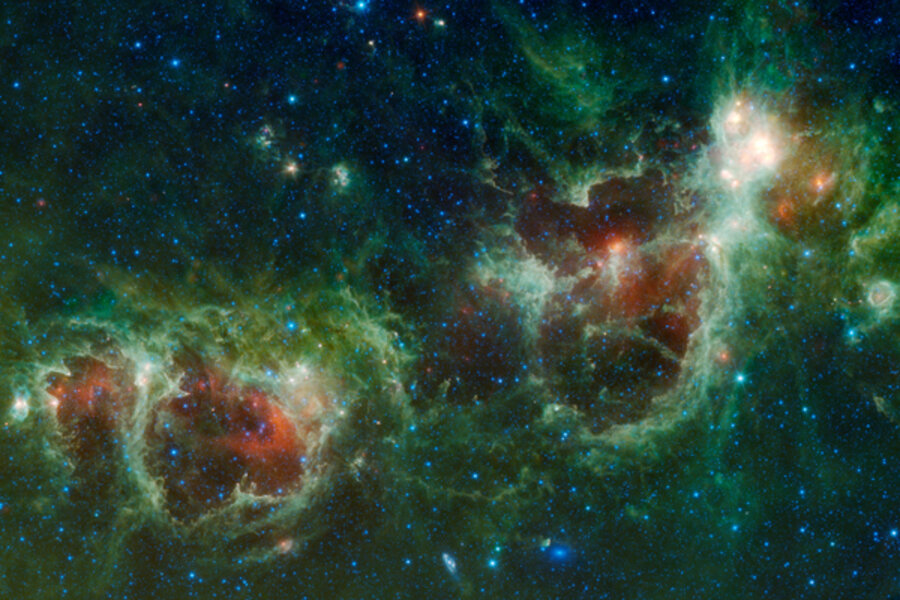NASA's WISE telescope delivers a stunning image of the Heart and Soul nebulae
Loading...
| Miami
Two massive, bubbling clouds of star-making factories were captured in a stunning photo by a NASA space telescope that is surveying the entire sky in infrared light.
The huge mosaic of the Heart and Soul nebulae was taken by the Wide-field Infrared Survey Explorer space telescope, which has completed approximately three-fourths of its infrared survey of the entire sky. A NASA advisory panel recently recommended that the telescope's mission end in October as planned, instead of extending its imaging work.
WISE was designed to detect the faint glow of distant objects with instruments chilled to the point where they produce no detectable infrared light.
IN PICTURES: Spectacular photos of supernovae
Currently, WISE is producing approximately 7,500 images a day in each of four infrared wavelengths.
"This new image demonstrates the power of WISE to capture vast regions," said Ned Wright, the mission's principal investigator at UCLA, who presented the new picture today at the 216th meeting of the American Astronomical Society in Miami. "We're looking north, south, east and west to map the whole sky."
Heart and soul
The two nebulae are located about 6,000 light-years away in the constellation Cassiopeia. The Heart nebula is so-called because of its resemblance to a human heart. The nearby Soul nebula also resembles a heart – only the more symbolic kind with two lobes.
Both massive star-making factories are marked by giant bubbles blown into surrounding dust by radiation and winds from the stars. WISE's infrared eyes allow it to see into the cooler and dustier crevices of these types of clouds, where gas and dust are just beginning to collect and form into new stars.
The new image was captured as WISE circled over Earth's poles, scanning strips of the sky. The image is a composite of 1,147 frames stitched together, taken with a total exposure time of three-and-a-half hours.
The WISE mission is set to complete its first map of the sky in July 2010. It will then spend the next three months surveying much of the sky a second time, before the solid-hydrogen coolant needed to chill the infrared detectors runs dry.
NASA plans to release the first installment of the public WISE catalog in summer 2011.
End of a mission?
The original 10-month WISE mission, which was launched in December and managed by the Jet Propulsion Laboratory in Pasadena, Calif., is scheduled to conclude when the supply of solid-hydrogen coolant runs out, which Wright predicts will happen in late October or early November.
But, since the spacecraft and telescope remain in good condition, Wright proposed a three-month extension of the WISE mission to complete the second half of the second sky survey in two of the four infrared wavelengths. WISE would be able to capture these images even after the hydrogen supply is exhausted and the instruments are no longer chilled.
The NASA panel advised against this three-month extension, which would have added $6.5 million to the program's $320 million price tag.
"It was a science per dollar decision, which is understandable," Wright told SPACE.com. "The first time you see something is always better than the second time you see it. And, because of the amount of data collected, WISE is a very expensive mission."
Wright is currently examining different options to keep WISE alive following the expiration of its mission. But, the problem remains the space telescope's large price tag.
"We haven't figured out if there's any inexpensive way to operate WISE and still take surveys," Wright said.
NEOs, Trojans and comets
About 960,000 WISE images have been beamed down from space to date. The telescope has snapped photos of star-forming clouds, remote, powerful galaxies, and speckled dots that are asteroids in our solar system.
So far, the mission has observed over 60,000 asteroids, most of which lie in the main asteroid belt, orbiting between Mars and Jupiter. About 11,000 of these near-Earth objects are newly discovered, and about 50 of these belong to a class of NEOs, which have paths that take them within about 30 million miles (48 million kilometers) of Earth's orbit.
One of the goals of the WISE mission is to study asteroids throughout our solar system and to uncover more clues about how they vary in size and composition. Infrared imaging helps with this because it can get more accurate size measurements of the space rocks than using visible light.
"Infrared will help us understand more about the sizes, properties and origins of asteroids near and far," said Amy Mainzer, the principal investigator of NEOWISE, a program that studies and catalogs asteroids detected by WISE.
WISE is also expected to study Trojans, which are asteroids that run along with Jupiter in its orbit around the sun in two packs – one in front of the gas giant, and one behind. The space telescope has already seen more than 800 of these objects, and by the end of the mission, it should have observed about half of all the 4,500 known Trojans.
The results of this study will address competing theories about how the outer planets evolved.
"WISE is the first survey capable of observing the two clouds in a uniform way, and this will provide valuable insight into the early solar system," said astronomer Tommy Grav of Johns Hopkins University in Baltimore, Md., who presented the information at today's meeting.
Comets have also made their way into WISE images, and more than 72 have been observed so far – more than a dozen of them new comets. WISE is taking a census of the different types of cometary orbits to help explain what kicks comets out of their original, more distant orbits and in toward the sun.


